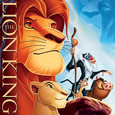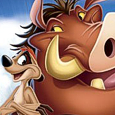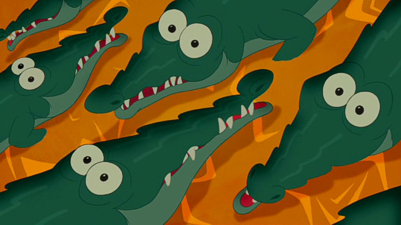Walt Disney Feature Animation (June 24 1994), Walt Disney Home Entertainment (October 4 2011), 1 Blu-ray 3D and 1 Blu-ray Disc plus DVD and Digital Copy, 88 mins plus supplements, 1080p high-definition 1.78:1 widescreen, 7.1 DTS-HD Master Audio, Rated G, Retail: $49.99
Storyboard:
Set in wide and wild beautiful African country landscapes, The Lion King tells the story of two kings: the present, Mufasa, and the one to be, young Simba. Things are all planned to go smoothly until Scar, Mufasa’s power hungry brother, frames Simba for Mufasa’s death (possibly the single most twisted scene in Disney history, played to the hilt by Brit baddie Jeremy Irons), and, taking the “throne”, banishes him forever from the Pride Lands in which they live. During his time in exile, Simba befriends a duo of freewheeling, wild-living hermits, Timon the meerkat and Pumbaa the warthog, who raise him as one of their own. When the Pride Lands begin to dry up and food becomes scarce (“Talk about your fixer-upper!”), Scar refuses to move his pride on, leading Simba’s childhood sweetheart Nala to search for help and a new place to dwell. Astonished to find him alive, she literally runs into Simba, and with Rafiki the old witch-doctor’s help, convinces the lion to return to the Pride Lands and face his Uncle for his rightful place on Pride Rock…

The Sweatbox Review:
Just who could have predicted that Simba, Timon, Pumbaa, Rafiki, Mufasa, Nala and Scar’s return to theaters just over a month ago would have come with such a mighty roar, in the form of phenomenal audience support that saw The Lion King’s promotional Blu-ray reissue confound box-office projections? Although one couldn’t really say The Lion King’s reissue was a “limited” release with over 4,000 screens booked to play the movie, the industry was sure that Disney’s hopes for $9-12 million were sure to be nearer a $6 million token opening. What with less than a month before the film hit home video again, who in their right mind would shell out family prices to see a film they could own in just a few weeks? Well, it turned out, just about everybody, and when the film opened to over $25m it was clear that the old Disney magic, spruced up in digital 3D, was still working. The “limited” engagement was extended and, even as the film makes its debut in high-definition (with 3D intact in the deluxe combo pack), The Lion King is still enjoying $100m+ grosses with more still to come from around the world!
After much talk of the 3D market misfiring theatrically this past summer and word that 3D is all but dead in the home having never really taken off, surely The Lion King’s release is shaping up to be the biggest push for the format yet. It’s something that Disney remains doggedly intent on pursuing given the concurrent but belated release of Beauty And The Beast in 3D, first on Blu-ray and then as a theatrical reissue early in 2012. That’s sure to be an interesting experiment, and one I have much interest in seeing how it plays out. Despite its surprise success, the appeal of The Lion King is totally understandable even today, what with its commercial music draw in Elton John and tremendous following. And although the disc release was days away, what parent – teenagers back in 1994 – couldn’t resist taking their kids to see one of their favorite films in the best way possible, back on the big screen (we’ll get to the aspects of the 3D presentation below)? Personally I was thrilled for its success, proving that classic Disney, done well, will always find an audience and that if the film is good, it doesn’t matter if it’s hand-drawn or not, a great success for traditional animation!

The Lion King’s new hit status also gave me a sense of déjà vu, for if anyone was genuinely surprised by the huge returns on a 17-year-old film in theaters, all they need do is look back on the original release, when the film was definitely what one could call a “sleeper hit”. During production, the story went through re-write and development hell, then-Studio head Jeffrey Katzenberg lost what little faith he had in the project during the marketing push (he is on record as complimenting his animators with the half-hearted remark that if the film grossed over $50 million, he would get on his hands and knees to apologize), and management had barely signed off on the film before moving on to what they truly perceived to be their jewel in the crown: Pocahontas. Then, suddenly, something happened. Audiences flocked to the film. Parents, who had taken their kids, went with other parents. Kids went back for second and third viewings with other kids. The audience that had built up during the 1990s animation renaissance of Beauty And The Beast and Aladdin came back again and again – Disney animation had another smash hit, though one so big that it proved to be a blessing and a curse.
Although the huge success of The Lion King paved the way for more research and development into animation technologies and the beginning of the animation toon-boom that saw rival companies Warner Bros, Fox Animation and, eventually, Katzenberg’s own DreamWorks enter the fray, it left Disney with a much bigger problem – namely, how to top it! The Studio has proven itself both its best friend and its worse enemy, and spent pretty much the entire next decade trying to bottle that lightning, extracting all the best elements of The Lion King and duplicating them in stories that do not necessarily fit the same mould. Each successive film (Pocahontas, Hunchback, Atlantis and Treasure Planet), enjoyable as many of them were, became more disparate as they were attempts to “better” themselves, but if The Lion King’s 3D theatrical reissue tells us anything, it’s that audiences prefer the back to basics approach and spontaneity of an underdog production. Although they all went through varying degrees of tortuous development, this is exactly how The Little Mermaid, Beauty And The Beast, Aladdin and The Lion King proved themselves, with the artists essentially stumbling across the next big thing by accident.

As for the film itself, can there be anybody out there (and especially reading this review) that has not seen it? With its new box-office and expected Blu-ray numbers accounted for, it remains the biggest animated movie of all time, seen by many more actual people than its nearest rival Finding Nemo, and the incidental instigator of the direct to video sequel (let us not forget that, while The Return Of Jafar was released first, that was ostensibly combined from the initial episodes of the Aladdin TV show, whereas Simba’s Pride had a complete narrative structure, fully designed as feature-length for home video from the outset and even given a limited theatrical release). An additional film, The Lion King 1½ – which runs with the notion that, if Lion King is Hamlet and Simba’s Pride is Romeo And Juliet, then Timon and Pumbaa’s viewpoint is the Rosencrantz and Guildenstern of the Pride Lands – remains perhaps the best of the direct-to-video pictures, with animation matching the being intercut with the original film seamlessly. Regular re-runs on the Disney television channels and a spin-off sidekick show based on Timon And Pumbaa means that at some point everyone has come into contact with these characters.
The original Lion King’s story itself is one that has been told time and time again but works so well, from the settings and the characters, to the situations, events and pay-offs throughout that make the film a classic. However, the film retains a slight idiosyncrasy for me, as I do have to be in the right “mood” to sit and watch it. I am constantly amazed by its visual delights (I nearly passed out with giddy excitement when I first saw that glorious camera dolly/pan around the top of pride rock as Mufasa explains the facts of the circle of life to young Simba!) and continue to find the score to be a revelation from Elton John, lyricist Tim Rice and Has Zimmer, but overall the film lacks the broad knockabout humor of Aladdin, or even Beauty And The Beast. Yes, it’s a drama, of course, and one mostly inspired by Hamlet (although one simply does have to mention Kimba: The White Lion, a minor controversy that’s still denied by the Studio), and is a different type of film to the examples just given, but I do find the ending to be unexceptionally drawn out, especially after the stunning sequences such as Be Prepared, the stampede and Can You Feel The Love Tonight.
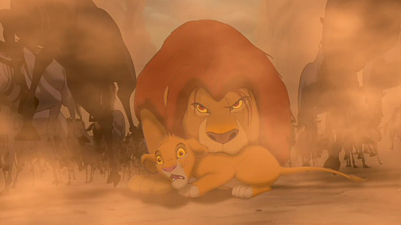
But that’s view that has gently faded over the years the more I have seen it, and getting past personal viewpoints there’s absolutely no denying The Lion King is a very decently made film that can truly be advertised as suitable for the whole family (adults included). Yes, there are scary moments (though not as scary as when the Witch offered Snow White the apple when I was only four years old!), but it sticks to the tried and tested formula that good will always win out over evil. Simba is a likable hero, the sidekicks – perhaps Disney’s best since Dumbo’s crows – know their place, and the villain, while not terribly active, plays delicious mind-games, something tricky to pull of in animation but expertly handled by Andreas Deja in a career highlight. Production-wise, it is simply sumptuous, with the kind of Deep Canvas imagery on show that was all created before the actual advent of Deep Canvas itself! The still pioneering integration of the 2D and 3D modelling reaches exceptional heights here, and only helps the new 3D makeover appear as if some shots were designed this way all along. Suffice to say that this is still one of the best looking animated features from any Studio out there, knocking the spots off of the competition of the time (and since).
Everything about The Lion King, from the voice talents to the date of release, fell into place with a magical karma that could never have been planned to perfection. As mentioned above, Jeremy Irons provides Scar with the hiss-able quality that we love in Kaa the snake from The Jungle Book (along with Bambi, it’s that film that can be as closely linked with The Lion King, suggesting a strong pedigree from the outset), while the other voices, made up from a wide spectrum of creeds and colors, just work in a way that no other feature can boast. Rice and John’s songs opened up an entirely new way of including music in an animated musical: I’ve seen the Circle Of Life opening so many times now, but one must never forget that this is what inspired the “narrative song voice” of the later Toy Story films, Tarzan, and DreamWorks’ The Road To El Dorado (also penned by Elton John) before they dropped traditional animation and inserted similar source songs from various catalogs in their CG comedies. So, if the Best Picture nominated Beauty And The Beast made people take notice of animation as a serious consideration, then The Lion King woke up the remaining people that hadn’t been aware and smashed the point home.
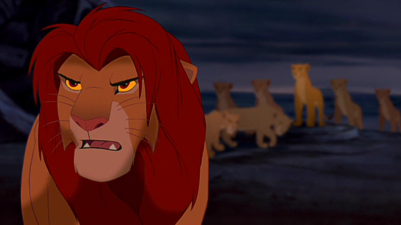
It did what all the great Disney animated films do, building on what had come before and laying the way for the likes of Toy Story to come along and find audience acceptance from people that had been reacquainted with the Disney brand. The Lion King is an amazing film, both in its scope, its execution and its final all-conquering of the box office. And although Beauty And The Beast had beaten it to the stage, it traversed the mediums to become a work of live art in itself, still playing around the world to this day. An Imax-formatted large screen reissue in the early 2000s didn’t produce the same kind of audience effect as we’ve seen with the 3D release, but then the film was still available on home video at the time and a much trumpeted additional scene, The Morning Report song lifted from the stage show, wasn’t that special an attraction. As with Beauty And The Beast, that Imax edition allowed for the finishing of some originally rushed animation and again as with Beauty serves as the basis for this latest release. Thankfully even the filmmakers agree that The Morning Report serves no purpose: give or take some alterations, this is the original theatrical cut of the film, just as we remember it!

Is This Thing Loaded?
I made mention in a review for last year’s fall Diamond Edition release that Beauty And The Beast set the bar pretty high for following titles in the series to match. Earlier this year Bambi did a fairly good job with its supplemental offerings, but unfortunately here, even over four discs including the film’s recent hit 3D edition, The Lion King’s extras just don’t roar anywhere as loud as they should, mainly down to the incredibly craptastic return of “Disney’s Virtual Vault”, a feature so lambasted after its debut on Fantasia that I hoped we’d seen the last of it.
The Blu-ray 3D disc, as usual, features nothing on the disc apart from the main feature. While there’s some argument that these discs should offer up some kind of 3D exclusive, or even just a few breadcrumbs, I can understand that they use the maximum amount of space to present the stereoptical edition of the movie, and withholding additional content from those unable to make the leap to 3D right now wouldn’t be such a good thing, but I’d always be interested in even a token featurette on how the post-conversion process was achieved.
This leaves the surprisingly limited number of new supplements to reside on the set’s sole regular Blu-ray Disc, all previously unseen in theory but not offering up anything Earth-shattering of particularly tremendous value to the package. Getting the promotional full out of the way, the BD and included DVD’s Sneak Peeks feature spots for Disney’s new All-Access online concept, Lady And The Tramp: Diamond Edition, the teaser trailer for The Muppets, Pixar sequel Cars 2, Tinker Bell adventures The Pixie Hollow Games and Secret Of The Wings, more Prep And Landing, Disney’s Movie Rewards and theme Parks, Disneynature’s “real-life Lion King” African Cats, Beauty And The Beast’s Enchanted Christmas, TreasureBuddies, a color-corrected Cinderella: Diamond Edition, The Lion King on stage, as well as a plug for separate Blu-ray releases for the Lion King DTVs Simba’s Pride and Lion King 1½ that will please those that passed on a concurrently released trilogy boxed set because of a lack of interest in the not particularly engrossing packaging.

The CG Zazu from the Platinum Edition DVD’s menu has been dropped in favor of a more predictable menu that just features the Pride Land backgrounds from the movie with some of the scenes projected on rocks, waterfalls, etc, with a basic text overlay offering up the options. It’s perfunctory, and ever so slightly pretentiously “arty”, but offers up nice views of the layout environments and does the job. At the top of the list is the Movie itself, accompanied by three playable options, the first of which is Disney Second Screen, which supposedly syncs up the movie to your choice of iPad gizmo or regular computer to offer additional pop-up and interactive elements that refer back to the movie throughout its duration.
While it all sounds cool, marrying up your player to the net isn’t always the easiest of things, especially given heavy traffic times that can see your virtual content slide out of sync with the movie. Much of this stuff is geared towards families by way of puzzles and games that most collectors wouldn’t be interested in anyway, and I do worry what happens when Disney loses interest in Second Screen or the material has to be removed offline again, rendering the feature redundant and in essence having made people shell out for inaccessible content. Some of it can be interesting, but again this was the kind of thing we were promised Blu-ray would offer right on the disc itself.
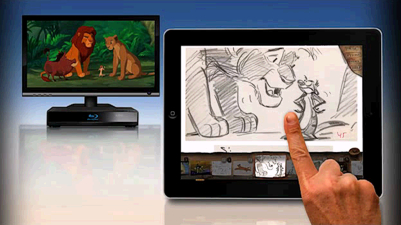
Some of it is interesting – concept art, animated flipbooks, etc – but it’s not a patch on having a picture-in-picture video commentary, and because it can be slow loading and freeform viewing, it’s a real rigmarole to keep resetting the sync throughout the movie. BD may well be the last deliverable home video format, but that’s all the more reason to place such content on the darned discs than to make us jump through internet-connected hoops in order to enjoy it, especially when non iPadders probably have their home theater and home computer set-ups in different rooms. A short What Is Disney Second Screen? demonstrates the feature and how the featured content should play in sync with the movie.
Play Movie also offers up a Sing-Along Mode which basically subtitles the lyrics throughout the film, and an Audio Commentary with producer Don Hahn and co-directors Rob Minkoff and Roger Allers. LaserDisc and Platinum DVD owners will have a huge feeling of déjà vu when listening to this track – it’s the exact same one as from the original 1995 laser set. While it’s a great listen – one of my all time favorites in fact – and has the participants in a wonderfully affecting up beat mood, their comments only reflect the “one year on” nature of the recording. Although they do go into detail on the behind the scenes aspects, pointing out the origins of the film, stories about the production as well as mistakes (cleaned up for the DVD and this BD), there is nothing new here for those who have heard this track before when it might have been cool to have Cine-Explore visuals added or at least allowed the Second Screen app to play alongside.
Bloopers & Outtakes uses Pixar’s famous flubbed lines of dialogue as inspiration for the animators to create “fun” visuals for them, although at under four minutes and without much to really work with, this just makes for a nice bullet point on the back of the packaging rather than anything substantial. Supposedly animated by the original artists themselves, not all the characters look on model and although I get a recurring gag with James Earl Jones’ Mufasa trying to find the right growl, it’s not actually “funny”, while when animated characters break out in laughter it never looks anything less than fake, and some of these are clearly staged.

Those hoping for an elaborate feature documentary along the lines of the exceptional Beyond Beauty exploration on the Beauty And The Beast: Diamond Edition Blu-ray are surely in for a huge disappointment with the new Pride Of The Lion King retrospective. Running a total of 38 minutes, the first half is actually very good, with Don Hahn hosting a reunion discussion of the film’s principal animators with a sharing stories around a campfire kind of approach. And following Beauty’s surprise inclusion of Jeffrey Katzenberg as an interviewee it’s great to see him again here since he played no small part in the making of the film. Even Michael Eisner gets to soundbite. But as the admittedly frank (and all the better for it) piece plays on, Pride Of The Lion King gets fragmented in speaking too much at length about the subsequent stage musical.
I’ve been wowed and amazed by that production both in New York and London, but it’s the movie that we should learn more about here and the over emphasis on the stage almost makes the movie redundant (something that I was pleased the theatrical reissue made a stab at balancing out again). This is a very well intentioned and made documentary, and the insights are never nothing less than eye-openers, but it’s just not on the level of depth that Beyond Beauty was, neither exploring the making of the film enough or presenting any kind of pop-up or branching features that lead off to explore Disney’s animal or natural history connections or associated content. There’s enlightenment and good honest information to be had – as always from a retrospective angle – but one gets the feeling that it’s still just skimming the surface.

Pulling the balance back towards the actual making of the film, The Lion King: A Memoir – Don Hahn (also the only extra on the bundled in DVD) does an exceptional 20 minute job of filling us in on the real stories behind the movie. Playing much like an extended sequence from his excellent feature documentary Waking Sleeping Beauty, Hahn offers up this “home movie” about the people that made The Lion King and continues the refreshingly honest tone of discussion that Waking had. Thus we hear how director George Scribner (who wanted to make a more naturalistic film and would nearly get his chance with Dinosaur before being removed again there) was swapped out for Minkoff, how the film switched from being called King Of The Jungle to The Lion King, and how the Los Angeles earthquake of 1994 almost put the film off target for its release. Everyone is heard from and there’s a wonderful amount of archive, making for a very real, very brilliant featurette.
A 15 minute bunch of Deleted Scenes do actually offer up five “new” moments from the film’s production, but although they’re presented HD encoded the source is a much-worn VHS so the increased resolution is minimally beneficial. Introduced by Allers and Minkoff, the scenes range from a wisely abandoned Hakuna Matata-style song for Mufasa (King Of The Wild, which just doesn’t work for his character) to small snippets of dialogue exchanges, but while reprises for Be Prepared and an alternate take on Simba meeting Nala may be fresh for Blu-ray owners, they were in fact already presented on the LaserDisc set, thus making them less exciting for long-time fans.

Also now “deleted” but actually presented under a Music & More banner, The Morning Report Extended Scene is only viewable as an alternate moment to the one that was in the original film. Ripped from the subsequent stage show and put in place of a dialogue scene that worked just as well without the song in the first place, I always found the song added little to the film other than publicity opportunity, and it is correctly referred to here as a promotional item that was inserted only for The Lion King’s Imax release. Having to compete with the previously established dialogue, the song didn’t really have the chance to breathe, being worked around the existing scene and ending up playing second fiddle to the original dialogue and story anyway. When Simba joins in for a verse, there’s a vocal gag that plays on the fact that he has Zazu stuffed in his mouth – but why add any lyrics when you can’t make them out, or indeed a song sung by a character whose vocalist (Rowan Atkinson) declined to return?
Morning Report works in the stage show because of the different format, and for those that enjoyed it in the film at least the sequence is available here, but thankfully smarter heads have deemed the theatrical cut was the correct choice in the first place. Lastly, yes lastly, an Interactive Art Gallery offers up four options (Character Design, Visual Development, Storyboards, Layouts And Backgrounds) that allow a look through The Lion King’s production art in the now standard Disney Blu-ray gallery approach. Images can be viewed in blocks or full-screen, bookmarked, sent to friends, etc…all bells and whistles that hide the fact that there are no publicity stills, although it’s nice to see the stunning backgrounds and gain an appreciation as to how the layers must have assisted in creating the 3D version.

And…that’s all folks!
Seriously…that’s it for the on-disc supplements on The Lion King: Diamond Edition; an almost scant hour and a quarter or so of video content when the Platinum Edition packed in a couple of hours more and Beauty And The Beast included an entire second Blu-ray disc of content.
So where’s the rest? Well in order to access some – but not even all – of the DVD’s original features, we have to turn to the craptacular return of Disney’s Virtual Vault, first introduced on the crushingly disappointing Fantasia Blu-ray release and still just as bad as it sounds. If you don’t have your Blu-ray connected up to the internet, then you’re not going to see a whole lot at all, for this further Lion King material has been stored online, ready to be selected via this disc. It’s as lame as it sounds, with the clips buffering, skipping and stuttering as the video catches itself, re-buffering as the connection may lag, and struggling to play cohesively. Of course, there’s no way to navigate forwards or backwards throughout this footage, but then the quality is so crummy I don’t think I’d want to.
And as with the Second Screen, what happens in the future when Disney inevitably decides to pull this material offline? It’s all well and good making some of those previous features available via a Virtual Vault, but then don’t make people pay out for a full-featured, $50 set when it’s anything but! In terms of technical quality, viewing convenience and buyer’s value, this is again the poorest decision Disney Home Video has ever made, and as with Fantasia a real disaster on a title as important as this. With a combined length of a couple of hours, why couldn’t this material have been included on a second disc? If the lack of high definition was an issue, then why not simply include a regular bonus feature DVD in the way that Warner Bros. often serves up its standard definition supplements?
Since Disney couldn’t be bothered to put these extras in the box, I won’t bother going over them, but for the record they are: The Making Of The Morning Report, further deleted scenes Bug Football, Timon’s Hakuna Matata verse and a comical Can You Feel The Love Tonight?, six Musical Journey and five Stage Journey featurettes, a Storyboard To Film Comparison, a couple of Early Concepts (Timon And Pumbaa Find Simba, Simba’s Presentation), the deleted song Warthog Rhapsody and the Elton John Circle Of Life music video.

WHAT’S MISSING?
Well, in a word, everything! Simply, let me just say that I am sooooo glad that I held on to my original Lion King LaserDisc box set and, having been bitten before by Disney’s failure to port over previous bonus features, the Platinum Edition DVD as well. Primarily missing, as ever, is the half-hour the Robert Guillaume hosted The Making Of The Lion King that made the LD but not the DVD. Much of that LD set’s material did make the original Platinum cut, but even given the Virtual Vault mess described above there’s still a lot that hasn’t been made available, amounting to well over three hours worth of material.
One or two games are less notable by their omission, as well as a Disney Channel kids edition of Circle Of Life along with a Making Of The Video clip; non-essential but why not include them anyway? In addition to Timon and Pumbaa’s version of Can You Feel The Love Tonight?, the LD also presented a very nice choral version, not included anywhere here or even in the virtual content. The Platinum DVD added several in-depth documentary featurettes (covering the film’s inspirations for its plot, the themes it explores and the development of the story), as well as further insights on the production including the crew’s African research trip and the art and influences they found there.
Further pieces included Reflections on the success of the film, a Storyboard Process clip, Andy Gaskill speaking about the Production Design, plus Character Design mini-clips exploring the animators and characters of the film. On old LD port was an in-depth discussion about the computer animation wildebeest stampede, plus additional character design galleries. The much-publicised contributions of Elton John and Tim Rice were also examined in a combination of archive and new interviews which also included the original crocodile animation from the Can’t Wait To Be King sequence, as well as speaking further to Hans Zimmer about the score, its African influence and the eventual Rhythm Of The Pride Lands audio album, the first extension of the Lion King brand.
In addition, the original music videos for all three of the single releases from the soundtrack, John’s Can You Feel The Love Tonight? and Circle Of Life, Lebo M’s Hakuna Matata were featured, before an extensive look into the workings of the stage musical, from it’s own origins to a publicity gallery. Some of these featurettes are covered in the virtual content, but they’re not here in the set, and still missing is a whole bunch of further stuff, from Roy Disney’s look at the animals of The Lion King at Disney’s Animal Adventure park that also included a very cool featurette on Walt’s affinity to animal pictures over the years, to the hysterical Hakuna Matata multi-language reel carried over from the LD.
Missing also are further looks at the international release and how the film was dubbed for each territory, and a gallery of foreign soundtrack and theatrical reissue artwork. The enhanced sound design for the Imax and DVD edition was also covered, and of course there are a number of other publicity items that would have been deemed essential, from the film’s Circle Of Life teaser trailer, to theatrical previews, TV spots and even outright promotional material for Rhythm Of The Pride Lands, Simba’s Pride and The Lion King 1½. A further game, Timon and Pumbaa’s Virtual Safari was also very well put together, though is more understandable in its absence, but that still doesn’t dismiss the three-hours-plus of material not included here.

one of many supplements NOT included in this DVD set
MORE TO DO THAN HAS BEEN DONE…
Far from being a case of more to see than can ever be seen, The Lion King’s Blu-ray debut is a colossal flop given the amount of material expunged from the set. What might have been? Well, following Beauty And The Beast’s lavish presentation, how about presenting the Second Screen material not as a net-connected series of waiting for things to update, but as a Cine-Explore picture pop-up option playing alongside the audio commentary (the original track or a new one)? Not that it needs it, but moving all the extras to a second Blu-ray disc would have afforded the option of the original cut or the Morning Report edition too.
Most importantly, forget Second Screen – why no second disc!? All of the first disc’s extras could have here, with the new documentary being the chief supplement heading up three distinct sections that account for the Screen, Stage and Legacy of the Lion King, with the film’s developmental aspects gathered in the Screen option, the eventual musical featurettes and promotions featured more appropriately in Stage, and such spin-offs as Rhythm Of The Pride Lands, the video sequels, merchandise, reissues, inspirations in the Animal Kingdom and theme parks and retrospective thoughts presented as a Legacy assortment.
Perhaps the standard definition aspect of some of that previously released material suggested it wasn’t worth an extra disc, but I don’t buy it: Disney has been shooting HD supplemental material for a number of years now and even if those clips couldn’t be presented this way then, more pertinently, why not update the film-based extras such as the multi-language reel, the other galleries and the inclusion of the film’s previews? The sheer sparseness of more than just three substantial new supplements on these discs is so astonishing that I actually spent a few minutes trying to find a missing link to a further stash of extras, obviously to no avail.
The two documentaries aside, even the rest of what we have just seems to skim the surface; yes, there’s a pretty remarkable art gallery, but where are any of the research trip’s photos or any publicity artwork? It’s just unimaginable that Disney’s biggest animated commercial success doesn’t warrant the full majestic treatment, especially given the $50 list price for this set when Beauty And The Beast’s same cost manages to pack in a full-to-the-brim second Blu-ray platter. That the movie’s disc itself isn’t exactly stuffed should have marked this down to around $35 or $40 top whack. The “great value” stated on the front sticker just isn’t to be found here. Speaking of which…
Case Study:
Following along the lines of the Studio’s recent 3D titles, The Lion King actually looks like it’s swapped out Beauty And The Beast’s cover and replaced fairytale characters with African animals in terms of the sleeve’s artwork and placement. The embossed multi-dimensional lenticular-fronted slipcover is in place, the aforementioned sticker on the front suggesting the “great value” that is sadly lacking within. Inside, the thick-width keepcase holds the five four platters along with the usual inserts (Movie Rewards code plus plugs for other Disney product and the All-Access online concept) as well as a Blu-ray Guide that’s the same in the 3D and flat combo packs and sports a predictably sparse looking navigational menu that states “this chart represents both Disc 1 and Disc 2 menus”, suggesting that maybe a second disc was on the cards at some point, and pathetic that it ultimately wasn’t included.
Ink And Paint:
Blu-ray 3D: It really gets my goat when traditional animation is referred to as “2D” because this infers the drawing has no sense of depth when, if anything, Disney’s animation has always had a feeling of weight and perspective. And more than most, The Lion King took these aspects to new dimensions even before any new trickery is added to the image. Coming after the spectacularly visuals of Beauty And The Beast and Aladdin, the animation crews at Walt Disney Feature Animation had gotten more and more used to the capability of the CAPS process, whereby the drawings were combined with the layouts and backgrounds via computer scanning.
This provided enhanced levels of depth in the layered artwork, along the lines of what Walt himself set out to achieve with the Multiplane Camera, and by the time of The Lion King’s composition, the artists were well up to speed as to how to fully explore its potential. Completely CGI backgrounds were also introduced, the dimensional animation introduced on Who Framed Roger Rabbit leading to unique combinations of hand-drawn and computer combined perspective animation and the eventual development of the Deep Canvas system.

Even before Deep Canvas, Beauty And The Beast and The Lion King created a great sense of depth to their delicately rendered palace locations and panoramic vistas, respectively, and so as the first two of the modern Disney features to be given a 3D makeover, those conversion crews were starting from an extremely advantaged place. Originally scheduled to open last year, Disney pulled the Beauty reissue due to a perceived lack of audience support either for the film, which had underperformed in its Imax run, or for 3D in general.
It seems in hindsight to have been a wasted opportunity: in time for its 3D debut just a few weeks later, The Lion King’s ostensibly promotional reissue cased great surprise by overshooting its predicted draw and out-grossed at least two major newcomers to theaters. One can’t say at over 4000 prints that it was a limited release, but what was phenomenal was the public response, a triumphant return clearly seeing audiences that saw Lion King as children now taking their own families to experience the film as they remembered it, on the big screen, and proving that there’s a solid, valid place for well-made traditionally animated films.
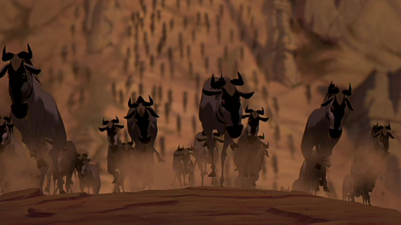
Almost immediately, Disney has announced that Beauty And The Beast and three other classics will be making their 3D debut in theaters starting from next January, although I await with interest what the public reception will be like. Beauty has of course just made its 3D debut on Blu-ray, and it remains a more classic, classy film to The Lion King’s rather brash commercial tone, although it must be admitted that there’s something to be said for Beauty’s conversion to three dimensions that The Lion King, good as it is, just can’t match.
The main reason seems to be locale: whereas Hanh’s fairytale was able to boast environments ranging from a small French hamlet to mysterious woods and the gothic architecture of the Beast’s castle, his African epic – tremendously realized though it is – is more repetitive in its design. The intricacy of Beauty is lacking more in the openly wide vistas of Lion King, and so we don’t have any walls to bounce off and give us as clearer sense of space. But that’s not to say I wasn’t almost as impressed with the film’s conversion as I was for Beauty’s.

Arguably the most layered of the CAPS features, The Lion King already has a great deal of inherent 3D to it, with some sequences suggesting (as did Beauty) that the artists had 3D in mind all along. This is impossible, of course, and more likely that they were striving to really push the feeling of depth in their medium exactly so as to dispel the notion of “2D animation”. Nevertheless, in these moments, The Lion King really works as an extra-dimensional presentation: the Circle Of Life opener is as awe-inspiring as the stage musical makes it, and the “camera pan” of Mufasa and Simba near the top of the film absolutely becomes jaw-dropping again.
Naturally the big set-piece sequences have been given the most attention, and that the wildebeests in the stampede were CG to begin with helps them fit into the stretched out environment even more. If there’s one thing I was impressed with most, it was how the conversion people managed to create the sense of dimension on the ground, as in their placing of the characters with “depth” between them. It’s this essence of space – and the closeness or lack of it – that gives the wildebeest stampede such immediacy, and Scar looking down as the drama plays out finally looks like he’s on a higher plane and as removed from the action as he seems to should be.

As always, the brighter nature of animation means that there’s less of a brightness loss when viewing the film through the needed glasses, and The Lion King’s sharp lines lend themselves to the technical nature of 3D, where “ghosting” can be apparent on high contrast visuals, such as The Nightmare Before Christmas. I Just Can’t Wait To Be King really bounces off the screen with colorful abandon, and in the couple of moments where darkness could have been a problem (Be Prepared and Simba’s vision of Mufasa), any loss in sharp edges and ghosting is faintly appropriate and not too distracting.
Again, The Lion King in 3D doesn’t beat the already remarkable results of Beauty And The Beast because of its overall lack of varied enough locations. The elephant graveyard gathers more depth, and the Pride Lands stretch off far into the horizon, but at other times the already-ultra-layered look just looks those layers have been enhanced with some force, ironically looking “flatter but more layered”. The 3D doesn’t make The Lion King a better film, and it continues to work just as well flat (just don’t say “2D”!), but I must admit that sometimes the effect is more astonishing than I might have been expecting.

Blu-ray Disc: When The Lion King was previously reissued for its large-screen Imax screenings, the film was given a Beauty And The Beast-style makeover, with certain scenes being reanimated to give more detail – particularly in facial expression – than was originally possible (or intended) back in 1994, alongside the inclusion of The Morning Report stage song shoehorned in. This time around the filmmakers have been careful to stress that the King’s return makes a point of going back to the original theatrical edition of the movie, but on inspection we find it mirrors Beauty And The Beast in more ways than one, with this “original” cut actually being the newer animated version, simply minus the new song.
Confused? Don’t be – while the purists among us will bemoan this fact until the lions come home, the majority of the audience will probably not notice a thing apart from maybe just noticing that the crocodiles in the Can’t Wait To Be King sequence look a little differently to how they remember them in 1994 and from their VHS tapes or LaserDiscs. I was lucky enough to pick up that original laser pressing of The Lion King back in 1995, where the film was presented in a faithful theatrical ratio of 1.85:1. However, true to the theatrical presentation this may have been, The Lion King was actually shot to a 1.66:1 negative, allowing for a little cropping top and bottom for theaters, and a lot of cropping left and right on home video.

Even then, the original VHS edition offered something of a hybrid, and as much was lost on the sides, the mattes were opened up top and bottom to allow less image information lost from those areas. But it was clear the wider theatrical crop was the correct intention and, unlike Beauty And The Beast, this framing was more than adequate, with one being able to see the progression of the filmmakers’ learning curve as they began to frame for wider images (Hahn’s later collaboration Atlantis: The Lost Empire would restore the even wider 2.35:1 ration to the Studio’s pictures).
But what some really wanted to see was the best of both worlds: the fully exposed negative ratio of 1.66:1, restoring all sides of any cropping from the north, south, east or west of the frames. Happily, the Platinum DVD delivered on that front, and it’s largely the same kind of transfer delivered here on Blu-ray, which offers another aspect ratio change yet again and settles for a happy medium of the native-HD 1.78:1 to retain the epic sweep of the cinematography. The colors have perhaps been “pushed” a little more: some scenes seem in danger of being very vibrant but don’t quite topple over the edge, while the image is crisp and clear, making those little Imax touch ups given to the animation throughout the film much more worthwhile.

Those with the LaserDisc sets may want to keep what they have though, as that original CAV edition will be the only way to see the true 1994 cut in the theatrical 1.85:1 ratio with production designer Chris Sanders’ original African-art inspired Can’t Wait To Be King crocodiles, which “original cut” or not have still been replaced here with much more cartoony critters at the request of the directors. It’s a very single shot in the entire movie, but the change is there to see and long-time fans will notice it, just as the eagle-eyed among you will pick up on the more static large format version’s end credits, no big deal but proof this isn’t quite the original original cut.
However, unlike some other changes to Disney’s films over the years, these switches are overall minuscule in the overall circle of life, and the good news all around is that this transfer really spruces up a movie that has always already looked very good. Even without the 3D I was very taken with the amount of depth the layered image had, and once or twice I shook my head to make sure I didn’t have the dimensional specs on, so vivid is the image that there really is more to see than has ever been seen. The Lion King on Blu-ray is simply eye-popping and stunning to look at, and with a lack of compression (indeed the movie disc is 8gb short of being full) or color banding issues, I can’t really see anyone finding fault with yet another pristine HD transfer from the Mouse House.

Scratch Tracks:
Wow! Assuming that this edition of The Lion King takes advantage of the recent theatrical reissue’s new soundtrack, be prepared to have the speakers on your walls shaken off! An already aggressive mix, especially in the loud action sequences, this 7.1 DTS-HD Master Audio is amazingly enveloping while preserving a spaciousness that opens up the audio that much more. It’s a dynamic track that does the required thing in making the big moments bigger but also keeps a natural level for the smaller moments such as Simba being taken to task by his Dad.
Dialogue is rock solid, although I did boost my center speaker by a notch or two since I personally found Zimmer’s orchestrations potentially in danger of swamping the voices, even though they sound newly warm and exhibiting such separation that one can almost hear the individual choral voices and instruments. Lebo M’s opening chant screams out and makes the start of the movie An Event, and James Earl Jones’ rumbling vocals gives a great weight to Mufasa that I don’t remember hearing with such clarity since the 1994 theatrical run.
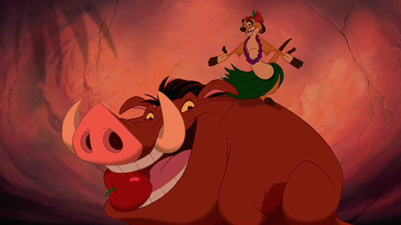
More than anything, home theater demo fans will be pleased to learn that their rear speakers will certainly get a dust-off as well, with a terrific amount, and perfectly placed, of surround activity not just in the top-end of the rocks shaking as the wildebeest begin their stampede but again in such small things as bringing aural life to the Pride Lands’ environments by way of atmospherics and vocal treatment. The high-powered Enhanced Home Theater mixes from the previous DVD suitably represent French and Spanish in 5.1 on the BD and the DVD, with English, French and Spanish subtitles also optional.
Final Cut:
If it weren’t for Don Hahn’s heartfelt personal memoir on the making of the film, there would be very little to recommend in the supplements of The Lion King: Diamond Edition. The main documentary is too preoccupied with the subsequent stage show – worthy and warranted of attention, but elsewhere please – and with the “virtual” housing of the previous bonuses this means there is little original archive available and we hear nothing from Elton John, widely credited with much of the original release’s success. However, unlike the previous Platinum Edition, this is very much a quality over quantity set, and the passage of time (and regime change!) means that some previously untold facts can come to the fore.
Unfortunately, though, these new revelations are essentially all we get, and the removal of the previous extras is simply inexcusable. While using much of what was already included on the LaserDisc, the Platinum DVD did make for a good assemblage of that material and a little more, all of it essential to have been included here in order to make this edition a suitable representation of Disney’s biggest animated feature on the current ultimate format. Yes, the movie looks and sounds great – that’s to be expected – but Disney is charging the same 5-disc price as it is for Beauty And The Beast’s 3D set as it is for a 4-disc serving here, and the accent on virtual content is hugely lamentable.
It’s nigh on impossible to believe that one of Disney’s most important films, and one that has just enjoyed such great renewed success, could ever be so uneventfully presented in an edition that really should be the epitome of the title’s home video incarnation. Just where, simply, is a second disc with over three-hours of known missing extras? Without them, and failing miserably to build on Beauty And The Beast’s standout offering last year and some of the other Diamond Editions to have sparkled so brightly, The Lion King hits the format in the first Disney Blu-ray to disappoint so largely since Fantasia, with not so much of a mighty roar, but an inadequate whimper.
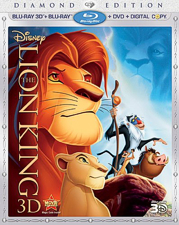 | ||
 |


